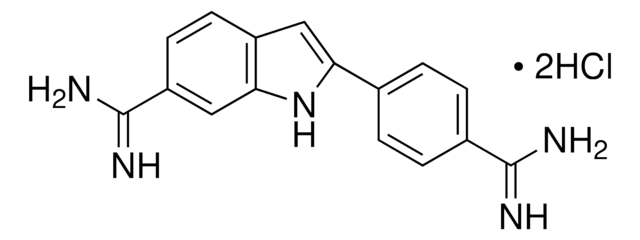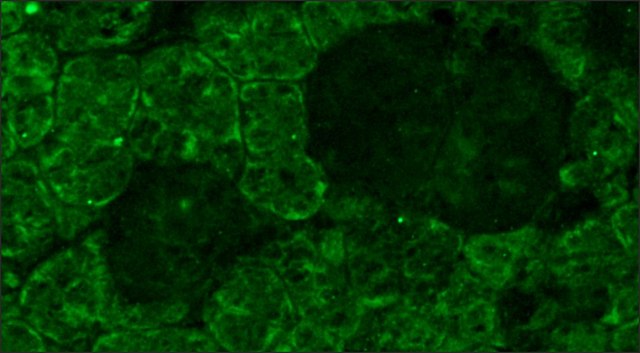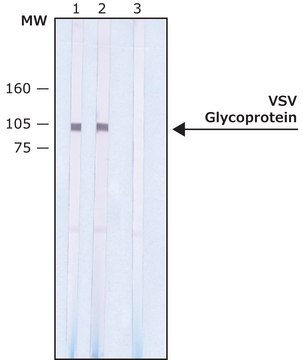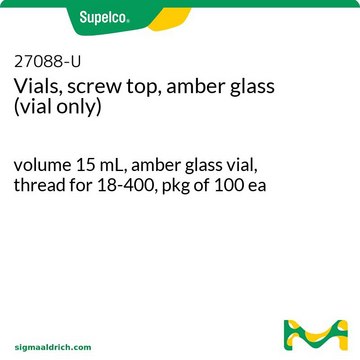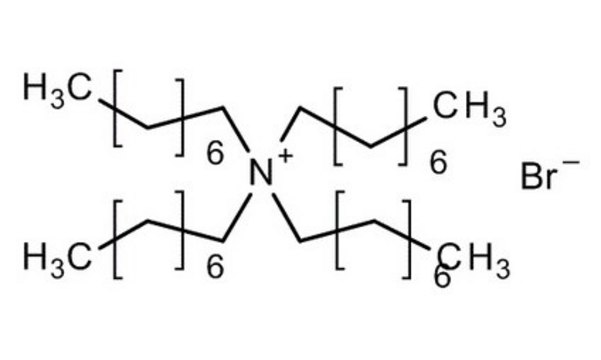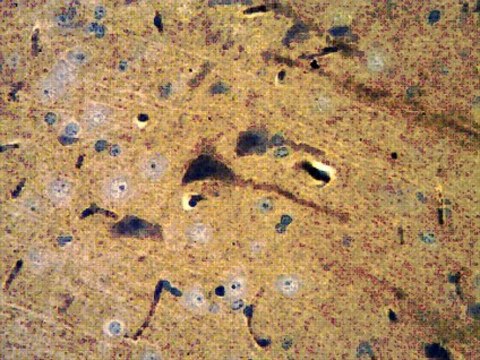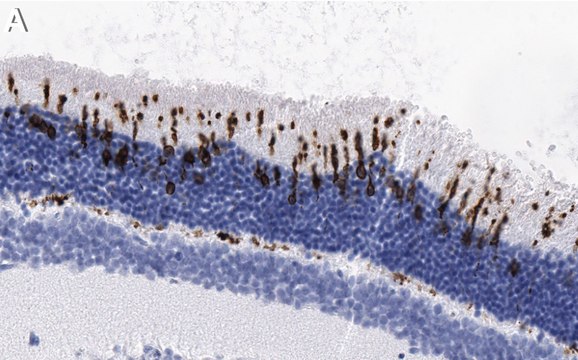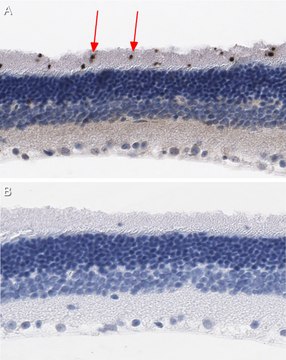推荐产品
生物来源
rabbit
抗体形式
unpurified
抗体产品类型
primary antibodies
克隆
polyclonal
种属反应性
mouse
种属反应性(根据同源性预测)
rat (based on 100% sequence homology)
技术
electron microscopy: suitable
immunofluorescence: suitable
immunohistochemistry: suitable (paraffin)
western blot: suitable
同位素/亚型
IgG
NCBI登记号
UniProt登记号
运输
ambient
靶向翻译后修饰
unmodified
基因信息
mouse ... Opn1Sw(12057)
一般描述
短波敏感视蛋白1(UniProt:P51491;又称S视蛋白、蓝锥感光色素、蓝敏感视蛋白、BOP、短波长敏感视锥蛋白)由鼠类物种中的Opn1sw(又称Bcp)基因编码(基因ID:12057)编码。视蛋白是具有感光细胞活性的G蛋白偶联蛋白。视蛋白包含通过三个细胞外环和三个细胞质环连接的七个跨膜α-螺旋结构域。它们是在视网膜感光细胞中发现的光敏蛋白质。基于序列同源性,视蛋白分为六个亚家族:脊椎动物视蛋白/脑视蛋白亚家族,Go视蛋白亚家族,Gs视蛋白亚家族,无脊椎动物Gq视蛋白亚家族,光异构酶亚家族和神经蛋白酶亚家族。它们在亚家族之间共享不到20%的同一性。视蛋白为吸收特定波长的光提供了必要的环境。因此,通过向视网膜提供不同的视蛋白,生物体可以感知不同波长的光。S-视蛋白是在视锥感光细胞中表达的多通道膜蛋白。它们是介导视觉的吸光分子,并含有与顺式视网膜共价连接的载脂蛋白视蛋白。它可以增加昏暗光线下的光谱敏感性。
特异性
该多克隆抗体可特异性检测鼠类物种中的短波敏感视蛋白1。鼠和人S-视蛋白显示88%的序列同源性。它靶向C末端区域17个氨基酸内的表位。
免疫原
KLH偶联的线性肽,对应于鼠短波敏感视蛋白1 C末端的17个氨基酸。
应用
抗S-视蛋白,目录号ABN1660是一种高度特异性的兔多克隆抗体,靶向短波敏感视蛋白1,并已在电子显微镜检查,免疫荧光,免疫组化(石蜡)和蛋白质印迹中进行了检验。
电子显微镜分析:代表性批次在COP-T/WT和MOP-T/WT小鼠的P30视网膜中检测到S-视蛋白(Chakraborty, D., et. al. (2009).Hum Mol Genet.18(5):797-808)。
蛋白质印迹分析: 代表性批次的1:1,000稀释液在小鼠视网膜提取物中检测到S-视蛋白(由Dr. Muna Naash at University of Houston, Houston, TX提供)。
免疫荧光分析:代表性批次在来自WT和COP-T/WT小鼠的石蜡包埋的视网膜和外节盘切片中检测到S-视蛋白(Chakraborty, D., et. al. (2009).Hum Mol Genet.18(5):797-808)。
免疫组化分析:代表性批次的1:1,000的稀释液在小鼠鼠视网膜组织中检测到S-视蛋白。
蛋白质印迹分析: 代表性批次的1:1,000稀释液在小鼠视网膜提取物中检测到S-视蛋白(由Dr. Muna Naash at University of Houston, Houston, TX提供)。
免疫荧光分析:代表性批次在来自WT和COP-T/WT小鼠的石蜡包埋的视网膜和外节盘切片中检测到S-视蛋白(Chakraborty, D., et. al. (2009).Hum Mol Genet.18(5):797-808)。
免疫组化分析:代表性批次的1:1,000的稀释液在小鼠鼠视网膜组织中检测到S-视蛋白。
质量
通过蛋白质印迹在NRL-/-KO Ms视网膜裂解物中进行了评估。
蛋白质印迹分析:该抗体的1:1,000的稀释液在5 µg NRL-/-KO小鼠视网膜裂解物中检测到S-视蛋白。
蛋白质印迹分析:该抗体的1:1,000的稀释液在5 µg NRL-/-KO小鼠视网膜裂解物中检测到S-视蛋白。
目标描述
观察分子量为〜37 kDa;计算分子量为38.92 kDa。在某些裂解物中可以观察到未鉴定的条带。
外形
形式:未纯化
其他说明
浓度:请参考特定批次的数据表。
未找到合适的产品?
试试我们的产品选型工具.
储存分类代码
12 - Non Combustible Liquids
WGK
WGK 1
闪点(°F)
Not applicable
闪点(°C)
Not applicable
Chun-Lei Deng et al.
Cell death and differentiation, 28(3), 1041-1061 (2020-10-22)
Photoreceptor apoptosis is recognized as one key pathogenesis of retinal degeneration, the counteraction of which represents a promising approach to safeguard visual function. Recently, mesenchymal stem cell transplantation (MSCT) has demonstrated immense potential to treat ocular disorders, in which extracellular
Yogita Kanan et al.
Free radical biology & medicine, 198, 118-122 (2023-02-04)
Retinitis pigmentosa (RP) is caused by many different mutations that promote the degeneration of rod photoreceptors and have no direct effect on cones. After the majority of rods have died cone photoreceptors begin to slowly degenerate. Oxidative damage contributes to
Yuntong Sun et al.
Journal of nanobiotechnology, 21(1), 449-449 (2023-11-25)
Photoreceptor apoptosis is an important pathogenesis of retinal degeneration and a primary cause of vision loss with limited treatment methods. Mesenchymal stem/stromal cells-derived small extracellular vesicles (MSC-sEVs) have shown therapeutic value in various ocular disorders. Recent studies have revealed that
Ashish Bhandari et al.
Frontiers in cellular neuroscience, 13, 426-426 (2019-10-15)
Axonopathy is a hallmark of many neurodegenerative diseases including glaucoma, where elevated intraocular pressure (ocular hypertension, OHT) stresses retinal ganglion cell (RGC) axons as they exit the eye and form the optic nerve. OHT causes early changes in the optic
Xiang Ren et al.
Diabetes research and clinical practice, 185, 109788-109788 (2022-02-20)
Autophagy and exosome secretion in photoreceptor and RPE cells play an important role during diabetic retinopathy (DR). Thioredoxin (Trx) upregulation delays diabetes-induced photoreceptor cell degeneration, which the effect of autophagy and exosome secretion on it is unclear. Therefore, we investigated
我们的科学家团队拥有各种研究领域经验,包括生命科学、材料科学、化学合成、色谱、分析及许多其他领域.
联系技术服务部门